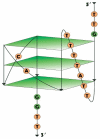The Functional Role of Loops and Flanking Sequences of G-Quadruplex Aptamer to the Hemagglutinin of Influenza a Virus
- PMID: 33673708
- PMCID: PMC7957560
- DOI: 10.3390/ijms22052409
The Functional Role of Loops and Flanking Sequences of G-Quadruplex Aptamer to the Hemagglutinin of Influenza a Virus
Abstract
Nucleic acid aptamers are generally accepted as promising elements for the specific and high-affinity binding of various biomolecules. It has been shown for a number of aptamers that the complexes with several related proteins may possess a similar affinity. An outstanding example is the G-quadruplex DNA aptamer RHA0385, which binds to the hemagglutinins of various influenza A virus strains. These hemagglutinins have homologous tertiary structures but moderate-to-low amino acid sequence identities. Here, the experiment was inverted, targeting the same protein using a set of related, parallel G-quadruplexes. The 5'- and 3'-flanking sequences of RHA0385 were truncated to yield parallel G-quadruplex with three propeller loops that were 7, 1, and 1 nucleotides in length. Next, a set of minimal, parallel G-quadruplexes with three single-nucleotide loops was tested. These G-quadruplexes were characterized both structurally and functionally. All parallel G-quadruplexes had affinities for both recombinant hemagglutinin and influenza virions. In summary, the parallel G-quadruplex represents a minimal core structure with functional activity that binds influenza A hemagglutinin. The flanking sequences and loops represent additional features that can be used to modulate the affinity. Thus, the RHA0385-hemagglutinin complex serves as an excellent example of the hypothesis of a core structure that is decorated with additional recognizing elements capable of improving the binding properties of the aptamer.
Keywords: DNA aptamer; G-quadruplex; affinity; hemagglutinin; influenza virus; structure−activity relationship.
Conflict of interest statement
The authors declare no conflict of interest.
Figures





Similar articles
-
Unveiling the unusual i-motif-derived architecture of a DNA aptamer exhibiting high affinity for influenza A virus.Nucleic Acids Res. 2025 Jan 7;53(1):gkae1282. doi: 10.1093/nar/gkae1282. Nucleic Acids Res. 2025. PMID: 39777463 Free PMC article.
-
Structural and Functional Aspects of G-Quadruplex Aptamers Which Bind a Broad Range of Influenza A Viruses.Biomolecules. 2020 Jan 10;10(1):119. doi: 10.3390/biom10010119. Biomolecules. 2020. PMID: 31936820 Free PMC article.
-
Aptamers that bind to the hemagglutinin of the recent pandemic influenza virus H1N1 and efficiently inhibit agglutination.Acta Biomater. 2013 Nov;9(11):8932-41. doi: 10.1016/j.actbio.2013.06.016. Epub 2013 Jun 20. Acta Biomater. 2013. PMID: 23791676
-
G-quadruplex DNA aptamers and their ligands: structure, function and application.Curr Pharm Des. 2012;18(14):2014-26. doi: 10.2174/138161212799958477. Curr Pharm Des. 2012. PMID: 22376117 Review.
-
Beyond G-Quadruplexes-The Effect of Junction with Additional Structural Motifs on Aptamers Properties.Int J Mol Sci. 2021 Sep 14;22(18):9948. doi: 10.3390/ijms22189948. Int J Mol Sci. 2021. PMID: 34576112 Free PMC article. Review.
Cited by
-
Applications in Which Aptamers Are Needed or Wanted in Diagnostics and Therapeutics.Pharmaceuticals (Basel). 2022 Jun 1;15(6):693. doi: 10.3390/ph15060693. Pharmaceuticals (Basel). 2022. PMID: 35745612 Free PMC article. Review.
-
Three- and four-stranded nucleic acid structures and their ligands.RSC Chem Biol. 2025 Feb 19;6(4):466-491. doi: 10.1039/d4cb00287c. eCollection 2025 Apr 2. RSC Chem Biol. 2025. PMID: 40007865 Free PMC article. Review.
-
Aptamer-coated track-etched membranes with a nanostructured silver layer for single virus detection in biological fluids.Front Bioeng Biotechnol. 2023 Jan 10;10:1076749. doi: 10.3389/fbioe.2022.1076749. eCollection 2022. Front Bioeng Biotechnol. 2023. PMID: 36704305 Free PMC article.
-
Multiplex Lithographic SERS Aptasensor for Detection of Several Respiratory Viruses in One Pot.Int J Mol Sci. 2023 Apr 29;24(9):8081. doi: 10.3390/ijms24098081. Int J Mol Sci. 2023. PMID: 37175786 Free PMC article.
-
Unveiling the unusual i-motif-derived architecture of a DNA aptamer exhibiting high affinity for influenza A virus.Nucleic Acids Res. 2025 Jan 7;53(1):gkae1282. doi: 10.1093/nar/gkae1282. Nucleic Acids Res. 2025. PMID: 39777463 Free PMC article.
References
-
- Novoseltseva A., Zavyalova E., Golovin A., Kopylov A. An insight into aptamer–protein complexes. Aptamers. 2018;2:1–19.
MeSH terms
Substances
Grants and funding
LinkOut - more resources
Full Text Sources
Other Literature Sources

